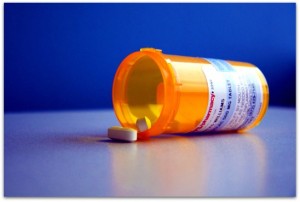
There are huge volumes of drug trials published, and for clinicians it’s clearly difficult to keep up to date with the latest evidence.
It is also clear that huge volumes of medicines are routinely prescribed, at a considerable cost to health services worldwide. For example, in the UK we spend £14.4bn per year on prescriptions, and most of this spend focuses on common conditions.
The aim of this recent meta-analysis by Leucht and colleagues (2015) was to explore the efficacy of 20 commonly prescribed medicines.

The annual UK health spend on prescriptions is £14.4 billion.
Methods
The 20 most commonly prescribed medications were identified by reviewing prescribing practices in the US. The therapy types identified, as reported, were:
- Hypertension (antihypertensive drugs)
- Cholesterol (statins)
- Depression (antidepressants)
- Anti-Ulcerants (proton pump inhibitors)
- Narcotics (analgesics for postoperative pain)
- Antidiabetes (metformin, GLP-1 analogues, DPP4-Inhibitors, SGLT2 inhibitors)
- Thyroid (thyroid preparations for hypothyreosis)
- Anti-Epileptics (epileptic seizures)
- Contraceptives (hormonal contraceptives for birth control)
- Respiratory (asthma, COPD)
- Antiplatelets/anticoagulants (acetylsalicylic acid)
- ADHD (amphetamines, methylphenidates)
- Insomnia (benzodiazepines)
- Benign Prostate Hyperplasia (a-adrenergic blockers, 5-alpha-reductase inhibitors)
- Schizophrenia (antipsychotics)
- Osteoporosis (bisphosphonates)
- Overactive Bladder (anticholinergics)
- Parkinson’s (levodopa)
- Migraine (analgesics)
- Alzheimer’s (cholinesterase inhibitors)
Psychiatric drugs directly relevant to mental health conditions have been highlighted in bold. As you can see, seven of the top 20 most prescribed medications were drugs commonly given for mental health conditions.
A PubMed search using PICO terms for each group was undertaken to identify published meta-analysis of mono-therapies. No date or language restrictions were applied. All patient data was included, although it’s not clear if the meta-analyses themselves had predefined criteria.

Antidepressants, antipsychotics, benzodiazepines, amphetamines, methylphenidate and cholinesterase inhibitors all appeared in the top 20 prescribed medications in the US.
Results
Meta-analyses could be identified for most conditions/interventions, and some areas had multiple meta-analyses undertaken (e.g. diabetes and hypertension).
No meta-analyses were identified in some areas (e.g. Thyroid, Anti-epileptics, Contraceptions, Benign Prostate Hyperplasia).
The publication dates ranged from 2000 to 2012, the majority of included meta-analyses had been published more than 5 years ago.
The AMSTAR scores (quality appraisal) ranged from 11/11 to 5/11, mean score 7/11, one score not reported.
17 topic areas had sufficient reviews to be reported on.
Only 11 of these 17 met the established threshold to be clinically important.
Effect sizes
Effect sizes were defined as:
- LARGE (>0.8 SMD), for example, proton pump inhibitors SDM 1.39 (95% Confidence Interval CI, 1.18 to 1.60)
- MEDIUM (SMD 0.5), for example, Antihypertensives 0.56 (95% CI, 0.54 to 0.58)
- SMALL (SMD 0.2), for example, Aspirin 0.12 (95% CI, 0.06 to 0.18)
Effects sizes for psychiatric drugs included:
- Benzodiazepines 0.65 (95% CI, 0.44 to 0.86)
- Antipsychotics 0.51 (95% CI, 0.43 to 0.59)
- Antidepressants 0.38 (95% CI, 0.34 to 0.41)

The effect sizes for commonly prescribed mental health medications were generally small to medium.
Conclusions
The author’s concluded:
We found that some of the medications have relatively low effect sizes with only 11 out of 17 of them showing a minimal clinically important difference…
We feel that we need to be more realistic about drug efficacy. Doctors may believe that all patients respond to drugs and none to placebo, but neither statement is true because there is no ideal drug and many disorders remit spontaneously due to their natural course…
We do not strive for therapeutic nihilism, but rather believe that drug data is complex and requires thoughtful consideration regarding which medications and therapies are best suited for certain situations and patients.

This review suggests that more training for physicians might be needed to get a more realistic view of drug efficacy.
Discussion
Evaluating the effectiveness of drugs is hugely complex, and it is worrying that commonly and routinely prescribed treatments often have only minimal evidence to support their use. This paper provides a useful starting point for clinicians. It’s helpful to compare effectiveness across commonly prescribed drugs, but there are limitations with the methods used. For example, each review was conducted separately with slightly different methodologies, it was not clear how reviews were selected when more than one was available. The majority of the reviews included had been published more than five years ago and were considered of low quality.
Trials often cherry pick participants excluding those arguably more representative of the general population. Effectiveness is normally evaluated in the short-term and is often not considered with co-prescribed medicines, or the chronic nature of conditions. Outcomes reported in trials and meta-analyses are often not patient determined, or take account of the costs, side-effects or iatrogenic effects of medicines taken.
Whilst some drugs may be moderately effective for example, benzodiazepines for insomnia, individuals taking them can develop tolerance very quickly, which can reduce their effectiveness within a few weeks.
It is also clear that there is significant within group variation of effectiveness (e.g. antidepressants or antipsychotics) with some drugs being more effective than others. Individual drug meta-analyses were excluded from this paper. Indeed the antipsychotic review included within this paper only examined atypical antipsychotics. It would be useful to repeat this review with more focus on mental health drugs.
The placebo effect of medicines is known to vary depending on a number of factors ranging from relationship with the prescriber to cultural beliefs, these remain very unexplored.

Drug efficacy should be established based on patient-oriented outcomes, but this review found it was often based on surrogate outcomes.
Links
Primary paper
Leucht S, Helfer B, Gartlehner G, Davis JM. (2015) How effective are common medications: a perspective based on meta-analyses of major drugs. BMC Med. 2015 Oct 2;13:253. doi: 10.1186/s12916-015-0494-1.
Other references
The Pharmaceutical Journal, 6/13 December 2014, Vol 293, No 7839/40, online | DOI: 10.1211/PJ.2014.20067182
Photo credits
- Véronique Debord-Lazaro CC BY 2.0
- 401(K) 2012 CC BY 2.0
- Dawn McIlvain Stahl CC BY 2.0
- Incase CC BY 2.0
- Michael Cochlan CC BY 2.0
- Dimitris Kalogeropoylos CC BY 2.0

RT @Mental_Elf: Commonly prescribed psychiatric drugs: do they work? https://t.co/G9o2mUveU0
Today @JohnBaker_Leeds looks at the evidence for antidepressants, antipsychotics & other psychiatric medication https://t.co/G9o2mUveU0
RT @JohnBaker_Leeds: Are mental health drugs as effective as other commonly prescribed ones – YES? My latest @Mental_Elf blog https://t.co/…
Psych meds are comparable in effectiveness to many other general medical drugs via @Mental_Elf https://t.co/rIUTnMvP8N
From the source paper in this blog which is #openaccess ADHD meds are in top 20 meds prescribed in US! https://t.co/rIUTnMvP8N
RT @Mental_Elf: Antidepressants, antipsychotics, benzos, methylphenidate & cholinesterase inhibitors in US top 20 prescribed drugs https://…
Commonly prescribed psychiatric drugs: do they work? https://t.co/Ep6LPbLbQO via sharethis
RT @JohnBaker_Leeds: What’s the efficacy of the top 20 drugs prescribed in the US (including many MH ones) my @Mental_Elf blog https://t.co…
#timetotalk 7 of the top 20 most prescribed meds in the US were drugs given for #mentalhealth disorders @Mental_Elf https://t.co/c5THwGV2GU
7 de los 20 fármacos más usados en USA son para problemas de salud mental; tienen tamaños del efecto pequeños/medios https://t.co/xaypVDRyv8
Commonly prescribed psychiatric drugs: do they work? https://t.co/YJZ5oaU3TW via sharethis
Don’t miss – Commonly prescribed psychiatric drugs: do they work? https://t.co/G9o2mUveU0 #EBP
RT @Mental_Elf: Recent paper finds effect sizes for commonly prescribed mental health medications were generally small to medium https://t.…
“Commonly prescribed psychiatric drugs: do they work?” https://t.co/pjeCYo1MR9
RT @JohnBaker_Leeds: How do mental health drugs compare to other commonly prescribed ones https://t.co/DUrU3n4Zpb today’s @Mental_Elf blog
Medicamentos más prescritos en USA. Commonly prescribed psychiatric drugs: do they work? https://t.co/WwAJmfmv15 vía @sharethis